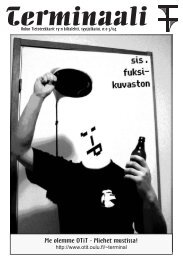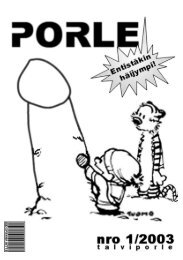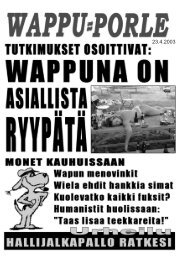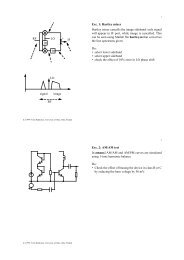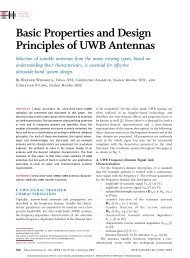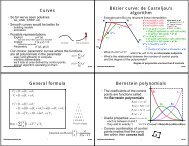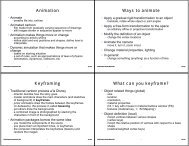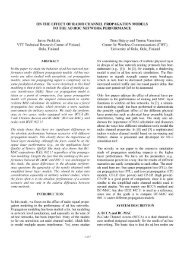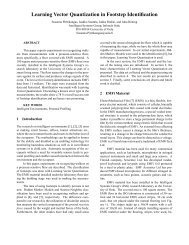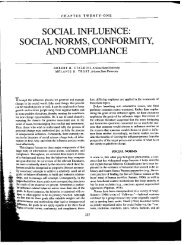Accurate, Dense, and Robust Multiview Stereopsis - Department of ...
Accurate, Dense, and Robust Multiview Stereopsis - Department of ...
Accurate, Dense, and Robust Multiview Stereopsis - Department of ...
You also want an ePaper? Increase the reach of your titles
YUMPU automatically turns print PDFs into web optimized ePapers that Google loves.
FURUKAWA AND PONCE: ACCURATE, DENSE, AND ROBUST MULTIVIEW STEREOPSIS 1367<br />
Fig. 7. The first filter enforces global visibility consistency to remove<br />
outliers (red patches). An arrow pointing from pi to Ij represents a<br />
relationship Ij 2 V ðpiÞ. In both cases (left <strong>and</strong> right), UðpÞ denotes a set<br />
<strong>of</strong> patches that is inconsistent in visibility information with p.<br />
3.3 Filtering<br />
The following three filters are used to remove erroneous<br />
patches. Our first filter relies on visibility consistency. Let<br />
UðpÞ denote the set <strong>of</strong> patches p0 that are inconsistent with<br />
the current visibility information—that is, p <strong>and</strong> p0 are not<br />
neighbors (8), but are stored in the same cell <strong>of</strong> one <strong>of</strong> the<br />
images where p is visible (Fig. 7). Then, p is filtered out as an<br />
outlier if the following inequality holds<br />
jV ðpÞjð1 g ðpÞÞ < X<br />
1 g ðpiÞ:<br />
pi2UðpÞ<br />
Intuitively, when p is an outlier, both 1 g ðpÞ <strong>and</strong> jV ðpÞj<br />
are expected to be small, <strong>and</strong> p is likely to be removed. The<br />
second filter also enforces visibility consistency but more<br />
strictly: For each patch p, we compute the number <strong>of</strong> images<br />
in V ðpÞ where p is visible according to a depth-map test. If<br />
the number is less than , p is filtered out as an outlier.<br />
Finally, in the third filter, we enforce a weak form <strong>of</strong><br />
regularization: For each patch p, we collect the patches lying<br />
in its own <strong>and</strong> adjacent cells in all images <strong>of</strong> V ðpÞ. If the<br />
proportion <strong>of</strong> patches that are neighbors <strong>of</strong> p (8) in this set is<br />
lower than 0.25, p is removed as an outlier.<br />
4 POLYGONAL MESH RECONSTRUCTION<br />
The reconstructed patches form an oriented point, orsurfel<br />
model. Despite the growing popularity <strong>of</strong> this type <strong>of</strong><br />
models in the computer graphics community [19], it<br />
remains desirable to turn our collection <strong>of</strong> patches into<br />
surface meshes for image-based modeling applications. In<br />
the following, we first propose two algorithms for initializing<br />
a polygonal mesh model from reconstructed patches,<br />
then a surface refinement algorithm, which polishes up a<br />
surface with explicit regularization constraints.<br />
4.1 Mesh Initialization<br />
4.1.1 Poisson Surface Reconstruction<br />
Our first approach to mesh initialization is to simply use<br />
Poisson Surface Reconstruction (PSR) s<strong>of</strong>tware [29] that<br />
directly converts a set <strong>of</strong> oriented points into a triangulated<br />
mesh model. The resolution <strong>of</strong> the mesh model is adaptive,<br />
<strong>and</strong> the size <strong>of</strong> a triangle depends on the density <strong>of</strong> the<br />
nearby oriented points: The denser the points are, the finer<br />
the triangles become. The PSR s<strong>of</strong>tware outputs a closed<br />
mesh model even when patches are only reconstructed for a<br />
part <strong>of</strong> a scene. In order to remove extraneous portions <strong>of</strong> the<br />
mesh, we discard triangles whose average edge length is<br />
Fig. 8. In the iterative snapping algorithm, for each vertex vi on the mesh<br />
model, we first collect ð¼ 10Þ patches ðviÞ that are closest to the line<br />
defined by vi <strong>and</strong> a surface normal nðviÞ at the vertex. A (signed)<br />
distance dðviÞ from vi to ðviÞ is used to compute photometric<br />
discrepancy term. See text for details.<br />
greater than six times the average edge length <strong>of</strong> the whole<br />
mesh since triangles are large where there are no patches.<br />
4.1.2 Iterative Snapping<br />
The PSR s<strong>of</strong>tware produces high-quality meshes <strong>and</strong> is<br />
applicable to both object <strong>and</strong> scene data sets. However, it<br />
cannot make use <strong>of</strong> the foreground/background segmentation<br />
information associated with each input image that is<br />
<strong>of</strong>ten available for object data sets. Therefore, our second<br />
approach for mesh initialization is to compute a visual hull<br />
model from the segmentation information, which is then<br />
iteratively deformed toward reconstructed patches. Note<br />
that this algorithm is applicable only to object data sets with<br />
segmentation information. The iterative deformation algorithm<br />
is a variant <strong>of</strong> the approach presented in [12].<br />
Concretely, the 3D coordinates <strong>of</strong> all the vertices in a mesh<br />
model are optimized by the gradient decent method while<br />
minimizing the sum <strong>of</strong> two per-vertex energy functions.<br />
The first function EsðviÞ measures a geometric smoothness<br />
energy <strong>and</strong> is defined as<br />
EsðviÞ ¼j 1 vi þ 2<br />
2 vij 2 = 2 ; ð9Þ<br />
where denotes the (discrete) Laplacian operator relative<br />
to a local parameterization <strong>of</strong> the tangent plane in vi, is<br />
the average edge length <strong>of</strong> the mesh model, <strong>and</strong>, with abuse<br />
<strong>of</strong> notation, vi denotes the position <strong>of</strong> a vertex vi ( 1 ¼ 0:6<br />
<strong>and</strong> 2 ¼ 0:4 are used in all our experiments). The second<br />
function EpðviÞ enforces the consistency with the reconstructed<br />
patches (photometric discrepancy term) <strong>and</strong> is<br />
defined as<br />
EpðviÞ ¼max 0:2; min 0:2; dðviÞ nðviÞ<br />
2<br />
; ð10Þ<br />
where nðviÞ is the outward unit normal <strong>of</strong> the surface at vi.<br />
dðviÞ is the signed distance between vi <strong>and</strong> the reconstructed<br />
patches along nðviÞ, which is estimated as follows:<br />
For each patch p whose normal nðpÞ is compatible with that<br />
<strong>of</strong> vi (i.e., nðpÞ nðviÞ > 0), we compute a distance between<br />
its center cðpÞ <strong>and</strong> the line defined by vi <strong>and</strong> nðviÞ, then<br />
collect the set ðviÞ <strong>of</strong> ¼ 10 closest patches (see Fig. 8).<br />
Finally, dðviÞ is computed as the weighted average distance<br />
from vi to the centers <strong>of</strong> the patches in ðviÞ along nðviÞ:<br />
dðviÞ ¼ X<br />
wðpÞ½nðviÞ ðcðpÞ viÞŠ;<br />
p2 ðviÞ




